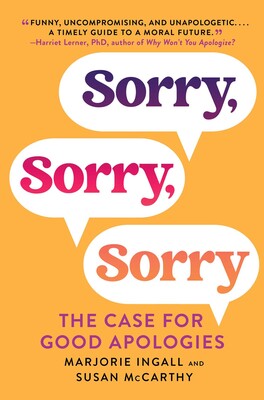Sorry, Sorry, Sorry: The Case for Good Apologies
By Marjorie Ingalls and Susan McCarthy
Gallery Books
ISBN: 978-1-9821-6349-5
Years ago, a friend of mine deplored apologies: “People just apologize because they want you to like them,” he observed.
That’s certainly true at least some of the time, but as Marjorie Ingalls and Susan McCarthy argue at length in their book Sorry, Sorry, Sorry, well-constructed and presented apologies can make the world a better place. For the recipient, they can remove the sting of old wrongs; for the giver, they can ease the burden of old shames.
What you shouldn’t do, when apologizing, is what self-help groups sometimes describe as “plan the outcome”. That is, you present your apology and you take your chances. Follow Ingalls’ and McCarthy’s six steps to construct your apology, then hope for, but do not demand, forgiveness, and don’t mess the whole thing up by concluding with, “So, we’re good?”
Their six steps to a good apology:
1. Say you’re sorry.
2. For what you did.
3. Show you understand why it was bad.
4. Only explain if you need to; don’t make excuses.
5. Say why it won’t happen again.
6. Offer to make up for it.
Six and a half. Listen.
It’s certainly true that many apologies don’t have the desired effect. Often, it’s because the apology itself is terrible. Through their Sorry Watch blog, Ingalls and McCarthy have been collecting and analyzing bad public apologies for years (obDisclosure: I send in tips on apologies in tennis and British politics). Many of these appear in the book, organized into chapters on apologies from doctors and medical establishments, large corporations, and governments and nation-states. Alongside these are chapters on the psychology of apologies, teaching children to apologize, practical realities relating to gender, race, and other disparities. Women, for example, are more likely to apologize well, but take greater risk when they do – and are less likely to be forgiven.
Some templates for *bad* apologies when you’ve done something hurtful (do not try this at home!): “I’m sorry if…”, “I’m sorry that you felt…”, “I regret…”, and, of course, the often-used classic, “This is not who we are.”
These latter are, in Ingalls’ and McCarthy’s parlance “apology-shaped objects”, but not actually apologies. They explain this in detail with plenty of wit – and no less than five Bad Apology bingo cards.
Even for readers of the blog, there’s new information. I was particularly interested to learn that malpractice lawyers are likely wrong in telling doctors not to apologize because admitting fault invites a lawsuit. A 2006 Harvard hospital system report found little evidence for this contention – as long as the apologies are good ones. It’s the failure to communicate and the refusal to take responsibility that are much more anger-provoking. In other words, the problem there, as everywhere else, is *bad* apologies.
A lot of this ought to be common sense. But as Ingalls and McCarthy make plain, it may be sense but it’s not as common as any of us would like.
